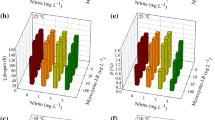Abstract
Organisms produce stress proteins as a response to natural and anthropogenic environmental changes. Induction of stress proteins has been reported in a variety of aquatic organisms, including rotifers, exposed to pollutants. Past studies on stress protein responses of rotifers have focused on exposure to single toxicants. In this study the rotifer Plationus patulus was exposed singly and in combination to various concentrations of As, Cr, Cu, Ni, Pb, and Zn. Following exposure, total protein was quantified (Bradford method) and stress protein 60 (HSP60) was identified using Western blotting. P. patulus induced HSP60 as a response to single exposures to Cr, Cu, Ni, Pb and Zn. HSP60 expression was increased (2 fold) in rotifers exposed to these single elements at both low and high concentrations as compared to unexposed rotifers. Arsenic exposure resulted in a 2 fold decrease in HSP induction. In rotifers exposed to metal mixtures, HSP60 was induced by the presence of As–Zn, As–Cr–Cu–Pb, As–Cr–Cu, As–Cr–Cu–Ni and As–Cr–Cu–Ni–Pb combinations in the media. HSP60 response to As and heavy metals toxicity depends on the type and number of elements present in the media as well as their concentrations and length of the exposure time.
Similar content being viewed by others
References
C. Y. Chen K. B Sillett C. L Folt S. L. Whittemore A. Barchowsky (1999) ArticleTitleMolecular and demographic measurements of arsenic stress in Daphnia pulex Hydrobiologia 401 229–238 Occurrence Handle10.1023/A:1003738427354
O. Choresh E. Ron Y. Loya (2001) ArticleTitleThe 60-kDa heat shock protein (HSP60) of the sea anemone Anemonia virdis: a potential early warning system for environmental changes Marine Biotechnology 3 501–508 Occurrence Handle10.1007/s10126-001-0007-4 Occurrence Handle14961344
B. J. Cochrane R. B. Irby T. W. Snell (1991) ArticleTitleEffects of copper and tributyltin on stress protein abundance in the rotifer Brachionus plicatilis Comparative Biochemistry and Physiology 98C 385–390
H. Eckwert G. Alberti H. R. Köhler (1997) ArticleTitleThe induction of stress proteins (hsp) in Oniscus asellus (Isopoda) as molecular marker of multiple heavy metal exposure: I. Principles and toxicological assessment Ecotoxicology 6 249–262 Occurrence Handle10.1023/A:1018682928839
N. Fernandez R. Beiras (2001) ArticleTitleCombined toxicity of dissolved mercury with copper, lead and cadmium on embryogenesis and early larval growth of the Paracentrotus lividus sea-urchin Ecotoxicology 10 263–271 Occurrence Handle10.1023/A:1016703116830 Occurrence Handle11556113
C. L. Folt C. Y. Chen M. V. Moore J. Burnaford (1999) ArticleTitleSynergism and antagonism among multiple stressors Limnology and Oceanography 44 864–877
Friedman, M., 1973. Oxidation reactions. The Chemistry and Biochemistry of the Sulfhydryl Group in Aminoacids, Peptides and Proteins. Pergamon Press Ltd. Headington Hill Hall, Oxford: 85
J. J. Gilbert (1975) ArticleTitlePolymorphism and sexuality in the rotifer Asplanchna, with special reference to the effects of prey-size and clonal variation Archiv für Hydrobiologie 75 442–483
K. Heinz-R. H. Eckwert (1997) ArticleTitleThe induction of stress proteins (HSP) in Oniscus asellus (Isopoda) as molecular marker of multiple heavy metal exposure: II. Joint toxicity and transfer to field situations Ecotoxicology 6 263–274 Occurrence Handle10.1023/A:1018635012910
L. E. Hightower (1993) ArticleTitleA brief perspective on the heat-shock response and stress proteins Marine Environmental Research 35 79–83 Occurrence Handle10.1016/0141-1136(93)90017-T
N. K. Karouna-Renier J. P. Zehr (1999) ArticleTitleEcological implications of molecular biomarkers: assaying sub-lethal stress in the midge Chironomus tentans using heat shock protein 70 (HSP-70) expression Hydrobiologia 401 255–264 Occurrence Handle10.1023/A:1003730225536
Kruger, N. J., 2002. The Bradford method for protein quantification. In Walker J. M., (ed.), The Protein Protocols Handbook. Humana Press Inc.: 15–21
S. Lewis R. D. Handy B. Cordi Z. Billinghurst M. H. Depledge (1999) ArticleTitleStress proteins (HSPs): methods of detection and their use as an environmental biomarker Ecotoxicology 8 351–368 Occurrence Handle10.1023/A:1008982421299
Locke, M., 2002. Overview of the stress response. In Locke M. & Noble E. G., (ed.), Exercise and Stress Response: The Role of Stress Proteins. CRC Press LLC, 1–11
Morimoto, R., A. Tissières & C. Georgopoulus, 1994. Progress and perspectives on the biology of heat shock proteins and molecular chaperones. In Morimoto, R., A Tissières, & C. Georgopoulus (eds), The Biology of Heat Shock Proteins and Molecular Chaperones. Cold Springs Harbor Laboratory Press: 1–29
A. S. Prasad (1993) Biochemistry of metallothionein E. Frieden (Eds) Biochemistry of Zinc Plenium Press New York 77–91
Snell T. W. & G. Persoone, 1989. Acute toxicity bioassays using rotifers. I. A test for brackish and marine environments with Brachionus plicatilis. Aquatic Toxicology 14: 65–80
M. Tedengren B. Olson B. Bradley L. Zhou (1999) ArticleTitleHeavy metal uptake, physiological response and survival of the blue mussel (Mytilus edulis) from marine and brackish waters in relation to the induction of heat-shock protein 70 Hydrobiologia 393 261–269 Occurrence Handle10.1023/A:1003583509218
K. Wah Chu K. L. Chow (2002) ArticleTitleSynergistic toxicity of multiple heavy metals is revealed by a biological assay using a nematode and its transgenic derivative Aquatic Toxicology 61 53–64 Occurrence Handle10.1016/S0166-445X(02)00017-6 Occurrence Handle12297370
C. E. Wheelock M. F. Wolfe H. Olsen M. L. Tjeerdema M. L. Sowby (1999) ArticleTitleHsp60-induced tolerance in the rotifer Brachionus plicatilis exposed to multiple environmental contaminants Archives of Environmental Contamination and Toxicology 36 281–287 Occurrence Handle10.1007/s002449900472 Occurrence Handle10047595
Wiegant, F. A. C., N. Spieker & R. van Wijk, 1998. Stressor-specific enhancement of hsp induction by low doses of stressors in conditions of self- and cross-sensitization. Toxi- cology 127: 107--119
Author information
Authors and Affiliations
Corresponding author
Rights and permissions
About this article
Cite this article
Rios-Arana, J., Gardea-Torresdey, J., Webb, R. et al. Heat Shock Protein 60 (HSP60) Response of Plationus patulus (Rotifera: Monogononta) to Combined Exposures of Arsenic and Heavy Metals. Hydrobiologia 546, 577–585 (2005). https://doi.org/10.1007/s10750-005-4308-x
Issue Date:
DOI: https://doi.org/10.1007/s10750-005-4308-x




